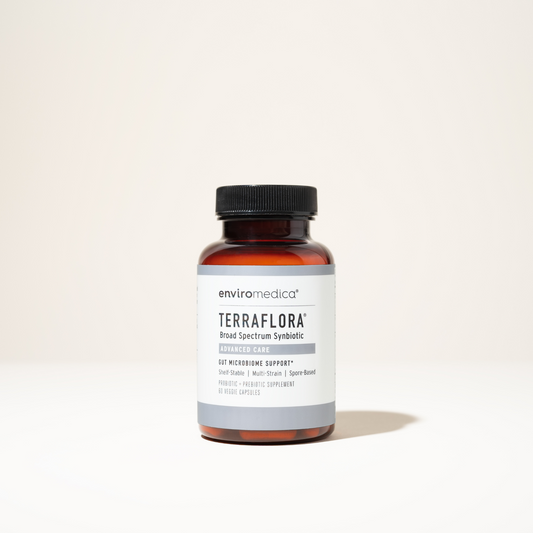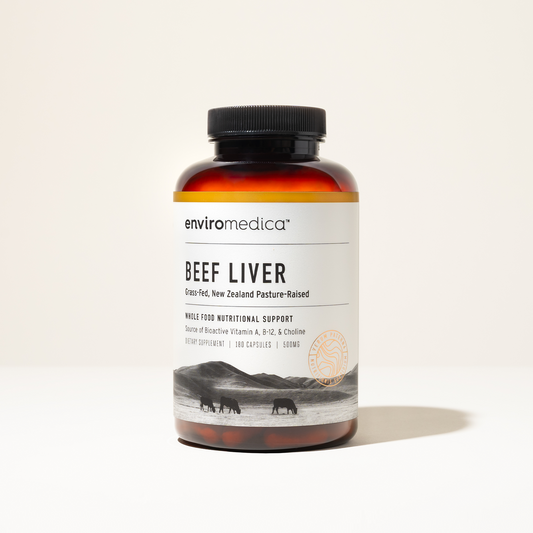Gut Microbiota, Neurodevelopment, and Childhood Behavior
Our gastrointestinal tracts harbor complex communities of microbes, collectively known as the gut microbiome. These microbes inhabit the gut through vaginal birth, breastfeeding, diet, and lifestyle. The microbiome contributes to epithelial barrier function, gut homeostasis, and immune system function.1 Recent research shows that the state of the microbiome has a much larger effect on the body than any other system. Brain development, mood, and behavior are all impacted by the microbiome. In this piece, we are discussing how disturbances within the microbiome can influence children’s mood and behavior, specifically addressing research pertaining to attention deficit disorder and autism.
Gut Health and Brain Development
Several recent studies support the gut microbiomes’ role in protecting the body from foreign pathogens and affecting pre and postnatal brain development. Communication between the gut microbiome and the brain are imperative for cognitive and behavioral development. The gut microbiome primarily establishes during birth and infancy; At the same time the gut microbiome is being established, and the brain is developing. Studies are showing a neuro-critical window of time in the prenatal and postnatal period where the gut microbiome significantly influences the development of the brain.2 3 Early life events such as antibiotic use, hospitalizations, formula feeding and cesarean delivery are associated with disturbances in the establishment of the gut microbiome, and higher incidences of brain related conditions such as ASD, ADHD, and other neurodevelopmental conditions.4 These events that affect the developing microbiome can also lead to mental health conditions later in life. 5
Recent findings generated from studies using germ-free rodents were fundamental in establishing the essentiality of communication between the gut microbiota and brain for normal cognitive and behavioral development. For example, germ-free mice showed reduced anxiety-like behavior and non-spatial memory, altered neurotransmitter levels in the brain, and altered hypothalamic–pituitary–adrenal (HPA) axis activity.6
There is an intricate dance that takes place between the microbes and the host. Gut microbes produce metabolites, which are precursors to hormones and neurotransmitters. These symbiotic bacteria influence our immune health, thus altering how our immune system communicates with our nervous system. Connected to these systems are the enteric and central nervous system, via the vagus nerve. The vagus nerve provides a direct route for neurotransmitters and microbes to communicate with one another.7
Microbes directly and indirectly shape neurochemical and immunologic responses that can subsequently affect behaviors and other neurological functions.8
Gut microbes regulate neurotransmitters in the brain. The mechanism by which this occurs is yet to be fully understood. We now know that metabolites of gut microbes can alter the permeability of the blood brain barrier, changing the neurotransmitter activity in the brain. However, there are many other potential pathways, yet to be fully explored.9
Microbiome and Autism Spectrum Disorder (ASD) and Attention Deficit Hyperactive Disorder (ADHD)
Autism spectrum disorder (ASD) comprises a set of complex neurodevelopmental disabilities characterized by repetitive/stereotypic behaviors and deficits in communication and social interaction.10 11 The cause of ASD remains to be fully understood. However, the gut microbiome has been implicated, as children with ASD tend to also struggle with gastrointestinal health.
A recent study12 involving children with ASD, found that by altering the gut microbiome through bowel cleanse and fecal transplant revealed a significant (80%) reduction of GI symptoms, including significant improvements in symptoms of constipation, diarrhea, indigestion, and abdominal pain. The researchers also found that behavioral ASD symptoms improved significantly, and remained improved 8 weeks after treatment ended! These researchers concluded,
This shifted gut microbiota of children with ASD toward that of neurotypical children is consistent with the hypothesis that gut microbiota may be at least partially responsible for GI and ASD symptoms.
Attention Deficit Hyperactive Disorder (ADHD) is also associated with gut dysbiosis. According to Dr Perlmutter, it is estimated that there are more than 6.5 million American children who have been diagnosed with ADHD. Making this even worse is the fact that about two-thirds of these children are receiving powerful, mind-altering medication, the long-term consequences of which have never been studied.
Dr Perlmutter discussed a study,13 which evaluated 742,939 children. Those children, who were diagnosed with ADHD, had a dramatic increased prevalence of constipation— three times higher than those without ADHD. Fecal incontinence was six times higher in the ADHD group, and the children diagnosed with ADHD had much more visits to the Doctor due to bowel issues. These findings did not differ between those on medications, and those that were not.
Perlmutter suggests that we embrace the notion that an altered gut microbiome plays a role in ADHD as well as across the spectrum of all brain related disorders. Gut dysbiosis associated with ASD/ADHD, affects various gut-brain axis pathways during neonatal and infant brain development.
Pathogenesis of Neurodevelopmental Issues
There are many different varying pathways involved in the microbiome gut-brain axis, all of which communicate and convey information back and forth between the gut and brain. Many factors can influence these pathways, such as: mode of birth, antibiotic use, environmental toxins, neurotransmitters, vagus nerve fibers, and inflammatory cytokines are all involved in this delicate dance. The hypothalamic–pituitary–adrenal axis, the central nervous system regulatory areas of satiety, and neuropeptides released from sensory nerve fibers affect the gut microbiota composition directly or through nutrient availability.14
Babies born via c-section are at a higher risk, as well as babies who are not breastfed. Medications such as antibiotics disrupt the gut microbiome, reducing diversity and creating an overgrowth of potentially pathogenic bacteria. The western diet, high in processed foods, also alters the gut microbiome. Therefore, dietary changes such as removing difficult to digest proteins like gluten and casein can be a valuable tool.15 All of these interventions have a profound effect on the infant’s future brain health.
The following chart compares mean intake of magnesium in various countries with the recommended daily intake from three sources. In no case is the average intake sufficient to meet even the lowest recommended intake.
The prenatal and postnatal early-life period is an extremely vulnerable window of time for neurodevelopment. Essential processes of communication between the gut and the brain are being established. The evidence surrounding the association with a healthy gut microbiome and its relationship with neurodevelopmental conditions such as ASD and ADHD is increasing. Much of the research done through animal models as well as more recent human research, shows us that impaired social behaviors may be reversed through recolonizing the gut with microbes. This understanding of gut dysbiosis, and repopulating the gut with beneficial bacteria sets the stage for potential future treatments for neurodevelopmental conditions. Interventions with pre and probiotics will become much more common in practice.16
Due to the bidirectional communication between the gut and the brain, it is possible that aberrant situations affecting either organ in early life can impact the other.
Environmental Microbes are Nature’s Inoculant
After infancy and mother’s milk, once children move to solid food and begin crawling around on the ground, there is an inoculation and rapid maturation of diversity of bacteria in the gut, provided by environmental microbes–which essentially are our second natural inoculant. Introducing a quality probiotic early on, especially one that mimics naturalistic exposure, can help cultivate a healthy microbiome.
Science teaches us that the human gut is central to optimal health, and the evidence effectively supports that biodiversity in the gut microbiota is reflective of a healthy individual. Through ancestral health philosophy and evolutionary study, we know human beings have always had naturalistic exposure to environmental microbes, with the majority being from soil exposure by way of diet and lifestyle. Terraflora™ allows the body to regain the much-needed exposure to healthy microbes absent in our hyper-sanitized, post-industrial civilization.
How the gut microbiome influences the infant’s brain and behavior during early life is an exciting new area of exploration in neuroscience.17
About the Author:
Kathryn is a functional nutritional therapist, author, editor, and mama of two boys. She
enjoys spending her free time out in nature-hiking and fishing. You can find her at www.primalmusings.com and her book “Forties on Fire” can be
found on Amazon.
References
- 1. Diaz Heijtz, R. (2016). Fetal, neonatal, and infant microbiome: Perturbations and subsequent effects on brain development and behavior. Seminars in Fetal and Neonatal. Volume 21, Issue 6, Pages 410–417. DOI: http://dx.doi.org/10.1371/journal.pone.0057431 Accessed June 1, 2017
- 2. Berding K & Donovan S (2016). Microbiome and nutrition in autism spectrum disorder: current knowledge and research needs. Nutrition Reviews, Vol 4 (12): 723-736. DOI: https://doi.org/10.1093/nutrit/nuw048 Accessed June 1, 2017,
- 3. Borre YE, O’Keeffe GW, & Clark G et al. (2014) Microbiota and neurodevelopmental windows: implications for brain disorders. Trends in Molecular Medicine, Vol 20, Issue 9, Pages 509–518. DOI: http://dx.doi.org/10.1016/j.molmed.2014.05.002 Accessed June 1, 2017
- 4. Berding K & Donovan S (2016). Microbiome and nutrition in autism spectrum disorder: current knowledge and research needs. Nutrition Reviews, Vol 4 (12): 723-736. DOI: https://doi.org/10.1093/nutrit/nuw048 Accessed June 1, 2017
- 5. Borre YE, O’Keeffe GW, & Clark G et al. (2014). Microbiota and neurodevelopmental windows: implications for brain disorders. Trends in Molecular Medicine, Vol 20, Issue 9, Pages 509–518. DOI: http://dx.doi.org/10.1016/j.molmed.2014.05.002 Accessed June 1, 2017
- 6. Berding K & Donovan S (2016). Microbiome and nutrition in autism spectrum disorder: current knowledge and research needs. Nutrition Reviews, Vol 4 (12): 723-736. DOI: https://doi.org/10.1093/nutrit/nuw048 Accessed June 1, 2017
- 7. Sampson TR & Mazmanian, SK (2015). Control of Brain Development, Function, and Behavior by the Microbiome. Cell Host & Microbe, Vol 17, Issue 5, Pages 565–576. DOI: http://dx.doi.org/10.1016/j.chom.2015.04.011 Accessed June 1, 2017
- 8. Sampson TR & Mazmanian, SK (2015). Control of Brain Development, Function, and Behavior by the Microbiome. Cell Host & Microbe, Vol 17, Issue 5, Pages 565–576. DOI: http://dx.doi.org/10.1016/j.chom.2015.04.011 Accessed June 1, 2017
- 9. Sampson TR & Mazmanian, SK (2015). Control of Brain Development, Function, and Behavior by the Microbiome. Cell Host & Microbe, Vol 17, Issue 5, Pages 565–576. DOI: http://dx.doi.org/10.1016/j.chom.2015.04.011 Accessed June 1, 2017
- 10. Berding K & Donovan S (2016). Microbiome and nutrition in autism spectrum disorder: current knowledge and research needs. Nutrition Reviews, Vol 4 (12): 723-736. DOI: https://doi.org/10.1093/nutrit/nuw048 Accessed June 1, 2017)). Research suggests that many children with ASD exhibit gastrointestinal issues such as constipation, leaky gut, and gut dysbiosis.
- 11. Sampson TR & Mazmanian, SK (2015). Control of Brain Development, Function, and Behavior by the Microbiome. Cell Host & Microbe, Vol 17, Issue 5, Pages 565–576. DOI: http://dx.doi.org/10.1016/j.chom.2015.04.011 Accessed June 1, 2017
- 12. Kang DW, Adams JB, & Gregory AC et al. (2016). Microbiota Transfer Therapy alters gut ecosystem and improves gastrointestinal and autism symptoms: an open-label study. Microbiome, Vol 5, Issue 10. DOI: https://microbiomejournal.biomedcentral.com/articles/10.1186/s40168-016-0225-7 Accessed June 1, 2017
- 13. McKeown C, Hisle-Gorman E & Eide M et al. (2013). Association of Constipation and Fecal Incontinence With Attention-Deficit/Hyperactivity Disorder. Pediatrics, Vol. 132, Number 5. DOI: https://doi.org/10.1542/peds.2013-1580 Accessed June 1, 2017
- 14. Petra Al, Panagiotidou S & Hatziagelaki E et al. (2016). From gut dysbiosis to altered brain function and mental illness: mechanisms and pathways. Clinical Therapeutics, Vol 37, Issue 5, 1 pp 984–995. DOI: https://doi.org/10.1038/mp.2016.50 Accessed June 1, 2017
- 15. Esparham A, Evans RG, & Wagner LE (2014). Pediatric Integrative Medicine Approaches to Attention Deficit Hyperactivity Disorder (ADHD). Children, Vol 1 Issue (2), 186-207 DOI: https://doi.org/10.3390/children1020186 Accessed June 1, 2017
- 16. Ho P & Ross DA (2017). More Than a Gut Feeling: The Implications of the Gut Microbiota in Psychiatry. Biological Psychiatry, Vol 81, Issue 5, Pages e35–e37. DOI: http://dx.doi.org/10.1016/j.biopsych.2016.12.018 Accessed June 1, 2017
- 17. O’Mahony SM, Clarke G, & Dinan TG et al. (2017). Early-life adversity and brain development: Is the microbiome a missing piece of the puzzle? Neuroscience, Vol 342 pp37-54. DOI: http://dx.doi.org/10.1016/j.neuroscience.2015.09.068 Accessed June 1, 2017





























